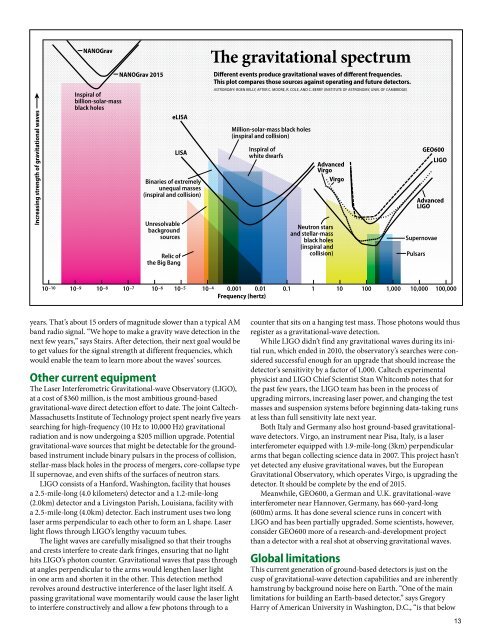GRAVITATIONAL WAVES
DIG-ASY-PRM_GravWavesFIN
DIG-ASY-PRM_GravWavesFIN
Create successful ePaper yourself
Turn your PDF publications into a flip-book with our unique Google optimized e-Paper software.
Increasing strength of gravitational waves<br />
NANOGrav<br />
Inspiral of<br />
billion-solar-mass<br />
black holes<br />
NANOGrav 2015<br />
eLISA<br />
LISA<br />
Binaries of extremely<br />
unequal masses<br />
(inspiral and collision)<br />
Unresolvable<br />
background<br />
sources<br />
Relic of<br />
the Big Bang<br />
The gravitational spectrum<br />
Different events produce gravitational waves of different frequencies.<br />
This plot compares those sources against operating and future detectors.<br />
ASTRONOMY: ROEN KELLY, AFTER C. MOORE, R. COLE, AND C. BERRY (INSTITUTE OF ASTRONOMY, UNIV. OF CAMBRIDGE)<br />
Million-solar-mass black holes<br />
(inspiral and collision)<br />
Inspiral of<br />
white dwarfs<br />
Advanced<br />
Virgo<br />
Virgo<br />
Neutron stars<br />
and stellar-mass<br />
black holes<br />
(inspiral and<br />
collision)<br />
GEO600<br />
LIGO<br />
Advanced<br />
LIGO<br />
Supernovae<br />
Pulsars<br />
10 –10 10 –9 10 –8 10 –7 10 –6 10 –5 10 –4 0.001 0.01 0.1 1 10 100 1,000 10,000 100,000<br />
Frequency (hertz)<br />
years. That’s about 15 orders of magnitude slower than a typical AM<br />
band radio signal. “We hope to make a gravity wave detection in the<br />
next few years,” says Stairs. After detection, their next goal would be<br />
to get values for the signal strength at different frequencies, which<br />
would enable the team to learn more about the waves’ sources.<br />
Other current equipment<br />
The Laser Interferometric Gravitational-wave Observatory (LIGO),<br />
at a cost of $360 million, is the most ambitious ground-based<br />
gravitational-wave direct detection effort to date. The joint Caltech-<br />
Massachusetts Institute of Technology project spent nearly five years<br />
searching for high-frequency (10 Hz to 10,000 Hz) gravitational<br />
radiation and is now undergoing a $205 million upgrade. Potential<br />
gravitational-wave sources that might be detectable for the groundbased<br />
instrument include binary pulsars in the process of collision,<br />
stellar-mass black holes in the process of mergers, core-collapse type<br />
II supernovae, and even shifts of the surfaces of neutron stars.<br />
LIGO consists of a Hanford, Washington, facility that houses<br />
a 2.5-mile-long (4.0 kilometers) detector and a 1.2-mile-long<br />
(2.0km) detector and a Livingston Parish, Louisiana, facility with<br />
a 2.5-mile-long (4.0km) detector. Each instrument uses two long<br />
laser arms perpendicular to each other to form an L shape. Laser<br />
light flows through LIGO’s lengthy vacuum tubes.<br />
The light waves are carefully misaligned so that their troughs<br />
and crests interfere to create dark fringes, ensuring that no light<br />
hits LIGO’s photon counter. Gravitational waves that pass through<br />
at angles perpendicular to the arms would lengthen laser light<br />
in one arm and shorten it in the other. This detection method<br />
revolves around destructive interference of the laser light itself. A<br />
passing gravitational wave momentarily would cause the laser light<br />
to interfere constructively and allow a few photons through to a<br />
counter that sits on a hanging test mass. Those photons would thus<br />
register as a gravitational-wave detection.<br />
While LIGO didn’t find any gravitational waves during its initial<br />
run, which ended in 2010, the observatory’s searches were considered<br />
successful enough for an upgrade that should increase the<br />
detector’s sensitivity by a factor of 1,000. Caltech experimental<br />
physicist and LIGO Chief Scientist Stan Whitcomb notes that for<br />
the past few years, the LIGO team has been in the process of<br />
upgrading mirrors, increasing laser power, and changing the test<br />
masses and suspension systems before beginning data-taking runs<br />
at less than full sensitivity late next year.<br />
Both Italy and Germany also host ground-based gravitationalwave<br />
detectors. Virgo, an instrument near Pisa, Italy, is a laser<br />
interferometer equipped with 1.9-mile-long (3km) perpendicular<br />
arms that began collecting science data in 2007. This project hasn’t<br />
yet detected any elusive gravitational waves, but the European<br />
Gravitational Observatory, which operates Virgo, is upgrading the<br />
detector. It should be complete by the end of 2015.<br />
Meanwhile, GEO600, a German and U.K. gravitational-wave<br />
interferometer near Hannover, Germany, has 660-yard-long<br />
(600m) arms. It has done several science runs in concert with<br />
LIGO and has been partially upgraded. Some scientists, however,<br />
consider GEO600 more of a research-and-development project<br />
than a detector with a real shot at observing gravitational waves.<br />
Global limitations<br />
This current generation of ground-based detectors is just on the<br />
cusp of gravitational-wave detection capabilities and are inherently<br />
hamstrung by background noise here on Earth. “One of the main<br />
limitations for building an Earth-based detector,” says Gregory<br />
Harry of American University in Washington, D.C., “is that below<br />
13


